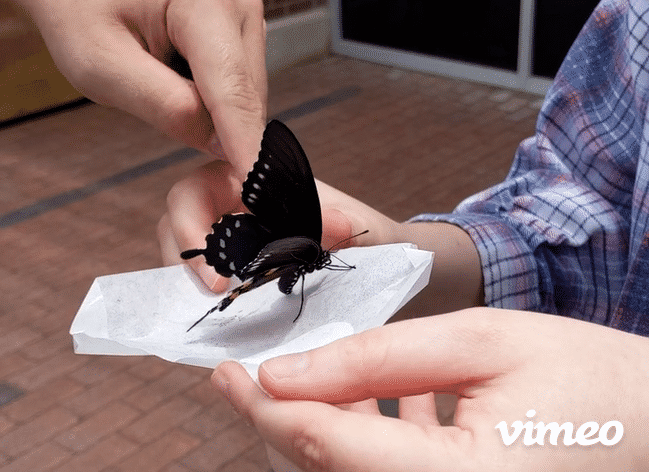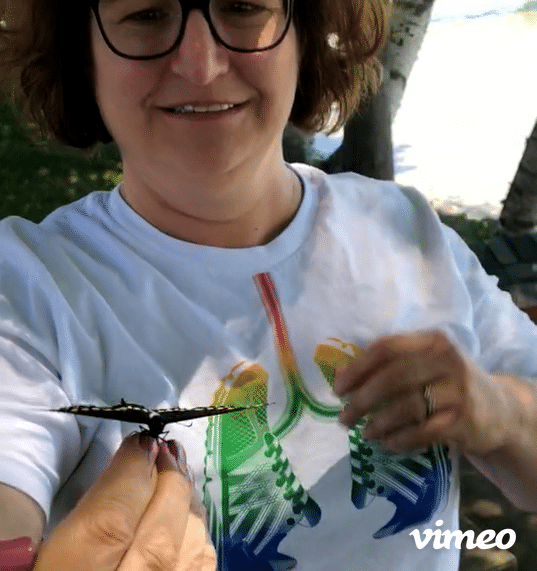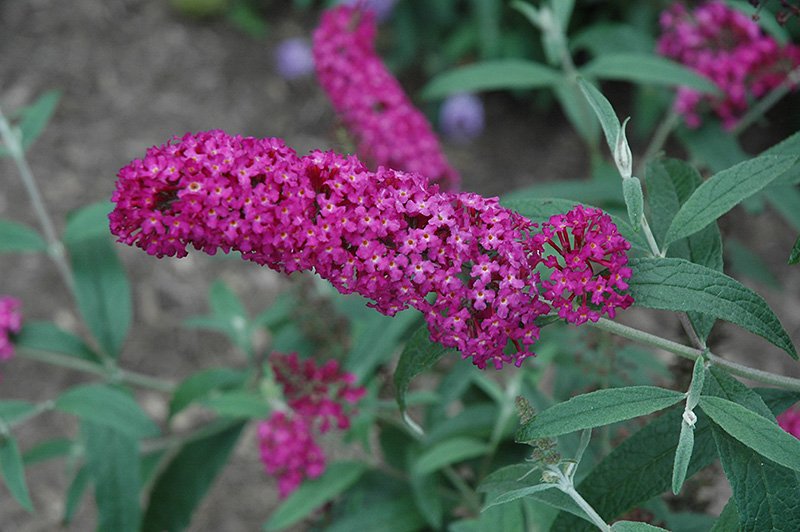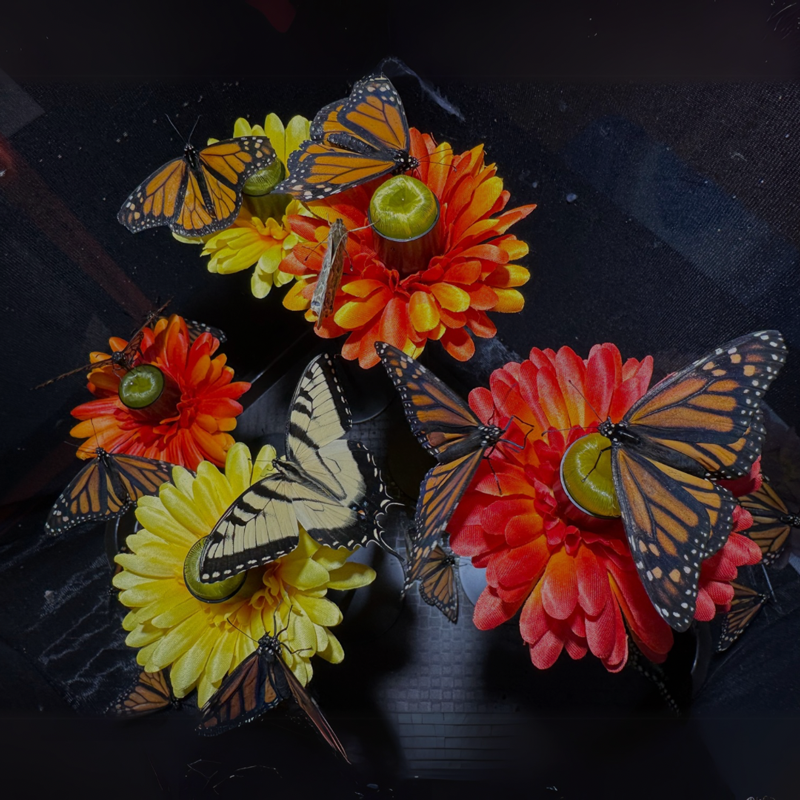
Supporting
Exhibits
Botanica, The Wichita Gardens
Greensboro Science Center
The Butterfly Haven
Milford Nature Center
Interested in working with us? Get in touch.
Butterflies are carefully shipped to educational exhibits in a manner that prioritizes their safety and well-being. Once the butterflies reach the chrysalis stage, they are packed into specialized containers that maintain the appropriate humidity and temperature to ensure their development remains uninterrupted during transit. These containers are designed to protect the fragile chrysalises from damage and prevent undue stress. Upon arrival at their destination, the chrysalises are transferred to exhibit environments where they can complete their transformation into butterflies. This process not only supports education and conservation efforts but also fosters a deeper appreciation for the beauty and importance of these fascinating pollinators.
An established schedule of shipments is preferred so that demand can be planned for and the variety and quantity of pupae requested can be provided. Please fill out our exhibitors contact form, and we’ll get back to you as soon as possible.
Making a
Difference.
A system of healthy pollinators is fundamental in the creation of the produce and goods upon which we depend—more than 90% of all plants need a pollinator to move pollen to create fruit. Unfortunately, habitat loss, overuse of pesticides, and effects of climate change have all contributed to the rapid decline of pollinator populations around the world.
To battle these unfortunate circumstances, I am tirelessly working to bolster pollinator populations via education, native habitat restoration projects, and utilizing ecologically friendly gardening practices. By providing hands-on, easily accessible, and educational experiences for people of all ages, I hope to raise awareness and garner support for our struggling pollinators.
-

International Butterfly Breeders Association (IBBA)
PRESIDENT & CURRENT MEMBER
Founded in 1998, IBBA is the largest and oldest professional butterfly farming trade association. Membership brings valuable knowledge, training and business benefits.
IBBA’s mission is to promote, educate, and protect the butterfly farming industry through education, sharing of evidence-based rearing methods, conservation, and political action. -

Association for Butterflies
CURRENT MEMBER
Association for Butterflies is a dynamic trade organization committed to providing valuable resources for professional butterfly farmers. As the industry leader in butterfly education since 2004, AFB is dedicated to equipping butterfly farmers to raise the healthiest, most vibrant butterflies possible.AFB supports members through the promotion of high quality rearing practices, continuing education, conservation outreach and research.
-

International Association of Butterfly Exhibitors and Suppliers
CURRENT MEMBER
The International Association of Butterfly Exhibitors and Suppliers is focused on butterfly exhibition and breeding – no other organization brings together more butterfly exhibitors and breeders on such a global scale. Our focus and goal is to protect butterflies in the wild and their natural habitats because without healthy ecosystems in which butterflies thrive, butterfly exhibition could not exist. -

Kansas Native Plant Society
CURRENT MEMBER
Promoting the awareness, appreciation,
and stewardship of Kansas native plants.
KNPS encourages awareness and appreciation of the native plants of Kansas in their habitats and in our landscapes by promoting education, stewardship, and scientific knowledge.














NEW!
Butterfly
Wing Charms
Choose our butterfly wing charms for your next gift and give the gift of freedom, beauty, and a reminder that change can be extraordinary. Experience the allure of nature encapsulated in these charming pieces. Each charm gives off a touch of elegance and whimsy, serving as a constant reminder of nature’s wonders and the cycles of life. Whether for a friend embarking on a new journey, a loved one celebrating achievements, or even for yourself, these charms hold the essence of beauty and transformation.

Framed
Butterflies
Enhance your space with a unique piece of art.
Enhance your home or office decor with a framed butterfly, a unique blend of nature and artistry. Each butterfly is carefully preserved and framed, displaying intricate details and vibrant colors. A framed butterfly serves as a stunning centerpiece and symbolizes transformation and resilience. Investing in one connects you with nature, bringing the outdoors inside. Each piece is ethically sourced — from us! Whether a gift or a personal addition, a framed butterfly elevates your decor with elegance and sophistication. Embrace its uniqueness and transform your space today.

Learn with us on Substack.
Frequently
Asked Questions
-
A butterfly farm is a facility where butterflies are bred and raised for commercial or conservation purposes. These farms typically cultivate a variety of butterfly species, providing them with a suitable habitat and the necessary food and conditions for their growth and development.
Butterfly farms can serve several purposes, including:
Conservation — Butterfly farms can help to protect and conserve butterfly populations that are threatened or endangered in the wild. By breeding and releasing healthy butterflies into their natural habitats, butterfly farms can help to bolster local populations and prevent extinction.
Education: Butterfly farms can provide educational opportunities for customers, allowing them to learn about butterfly behavior, life cycles, and habitats. Some butterfly farms also offer workshops to teach customers about butterfly farming and conservation.
Commercial: Some butterfly farms breed and sell butterflies to research labs, exhibits, zoos, and other organizations.
-
On our farm we have specially designed enclosures and netted flight houses where butterflies can live, breed, and lay eggs. We breed all of our butterflies and none come from wild populations.
Over the last few years we have worked hard to establish gardens cultivating a wide variety of larval host plants to feed our caterpillars. Theses plants attract wild butterflies to lay eggs. Occasionally we collect these eggs to generate a new line of breeding stock.
Other times we collaborate with other farms who have their own distinct genetic lines of breeding stock. These genetic lines can be merged with ours to maintain a sustainable population of butterflies for various purposes, such as educational programs, exhibits, research, or releasing them into the wild for conservation efforts. -
These delicate creatures, with their vibrant colors and graceful flight, are not mere ornaments of nature but play a crucial role in maintaining the delicate balance of our environment.
Pollination
Butterflies are exceptional pollinators. As they flutter from flower to flower, sipping nectar for sustenance, they inadvertently transfer pollen grains from the male parts of a flower to the female parts, enabling fertilization and subsequent fruit and seed production. It is estimated that butterflies, along with other pollinators, contribute to the pollination of over 75% of global food crops. Without their diligent work, our agricultural systems would collapse, leading to a severe decline in food production and potential food shortages.Indicators of Ecosystem Health
Butterflies act as indicators of a healthy environment. Due to their sensitivity to changes in habitat, population declines or shifts in their distribution patterns can serve as early warning signs of ecosystem degradation. By monitoring butterfly populations, scientists can gain insights into the overall health of ecosystems, identifying environmental issues such as habitat loss, pollution, or climate change. Preserving butterfly habitats not only ensures the survival of these enchanting creatures but also safeguards the well-being of countless other organisms that depend on the same ecosystems.Food Source
Butterflies are a crucial source of food for other wildlife. Birds, bats, reptiles, amphibians, and even some small mammals like to add butterflies to their dinner plate.Biodiversity Conservation
Butterflies contribute to biodiversity conservation. With their intricate life cycles and specific habitat requirements, different species of butterflies are highly specialized to particular ecosystems. Protecting these habitats for butterflies means preserving a vast array of plant and animal species that coexist within the same ecosystems. The intricate interconnectedness of biodiversity ensures the stability and resilience of our planet, making it essential to safeguard every component, including the butterflies.Aesthetic & Cultural Value
In addition to their ecological significance, butterflies bring immense aesthetic and cultural value to our lives. Their exquisite beauty and graceful flight have captivated human hearts for centuries. From ancient art to modern poetry, butterflies symbolize transformation, renewal, and the delicate balance of nature. Their presence in gardens and parks brings joy to people of all ages, fostering a deep appreciation for the natural world and the need to protect it.
-
Plant Milkweed
Monarch butterflies rely on milkweed as their sole source of food for larvae, and it’s also the only plant where they lay their eggs. By planting native milkweed in your backyard or community garden, you can provide a crucial habitat for monarchs to lay their eggs and for their larvae to feed on.Provide Nectar Sources
Adult monarchs rely on nectar from flowers as their primary source of food. Plant a variety of native and other beneficial flowering plants in your garden to provide a continuous source of nectar throughout the growing season, which will help sustain butterfly populations.Avoid Pesticides
Pesticides are harmful to butterflies, and their use is one of the major contributors to the decline in monarch populations. Instead of relying on chemical pesticides to control pests in your garden, explore natural alternatives like companion planting, handpicking pests, or using insecticidal soap.Support Conservation Efforts
Contribute to butterfly conservation efforts by donating to organizations that focus on protecting butterflies and their habitats. These organizations often work on research, habitat restoration, and public education initiatives.Participate in citizen science projects
Get involved in citizen science projects that monitor and document butterfly populations. By recording butterfly sightings or participating in butterfly counts, you can help researchers collect valuable data to better understand butterfly populations and their conservation needs.Educate others
Raise awareness about the importance of butterfly conservation by educating your friends, family, and community. Share information about the decline of butterfly populations, the importance of their role in ecosystems, and ways people can help protect them.Support butterfly-friendly policies
Stay informed about local, regional, and national policies that impact butterfly conservation. Support initiatives that promote the protection of butterfly habitats, ban harmful pesticides, and encourage sustainable land management practices.Volunteer your time
Look for volunteer opportunities with local butterfly gardens, nature reserves, or conservation organizations. You can assist with butterfly surveys, habitat restoration projects, or educational programs.
-
Butterflies, with their strikingly beautiful wings and delicate appearance, are a familiar sight during warmer months. However, as temperatures drop and winter approaches, these winged creatures start to disappear. But where do butterflies go in winter?
The answer to this question varies depending on the species of butterfly. Some species, such as monarch butterflies, undertake an incredible migration. Every year, millions of monarch butterflies travel thousands of miles from their breeding grounds in Mexico to the United States and Canada. This migration allows them to escape the cold winter temperatures and find food and water in warmer climates.
Other butterfly species, such as the swallowtail, overwinter in different stages of life, such as larvae or pupae, in shelters they create or in a specific location. They can also find safe spaces on the trunks and under the bark of trees, or in hibernacle-like shelters, where they can help regulate their temperature, preventing them from freezing in colder temperatures.
Even in winter, it is still possible to spot a butterfly if you know where and how to look. Some species, such as the mourning cloak, emerge as soon as temperatures rise above freezing and can even be seen flying in the snow.





















